2022 MGT5PMT (S2) Project: Virtual Teams in Project Management
VerifiedAdded on 2022/11/21
|7
|2035
|238
Report
AI Summary
This report examines the increasing significance of virtual teams in project management, particularly in the context of the COVID-19 pandemic and other crises. It highlights the advantages of virtual teams, including cost savings through reduced overhead, increased talent accessibility by enabling global recruitment, enhanced flexibility in communication and procurement, and improved productivity due to 24/7 work schedules across different time zones. The report emphasizes the importance of leadership and the use of project management software, such as Jira, to maintain and empower these teams. The report provides insights into maintaining project continuity during crises, focusing on scheduling, resource allocation, and budget management. By exploring the application of virtual teams, the report offers a strategic vision for organizations striving for success in an evolving business landscape.
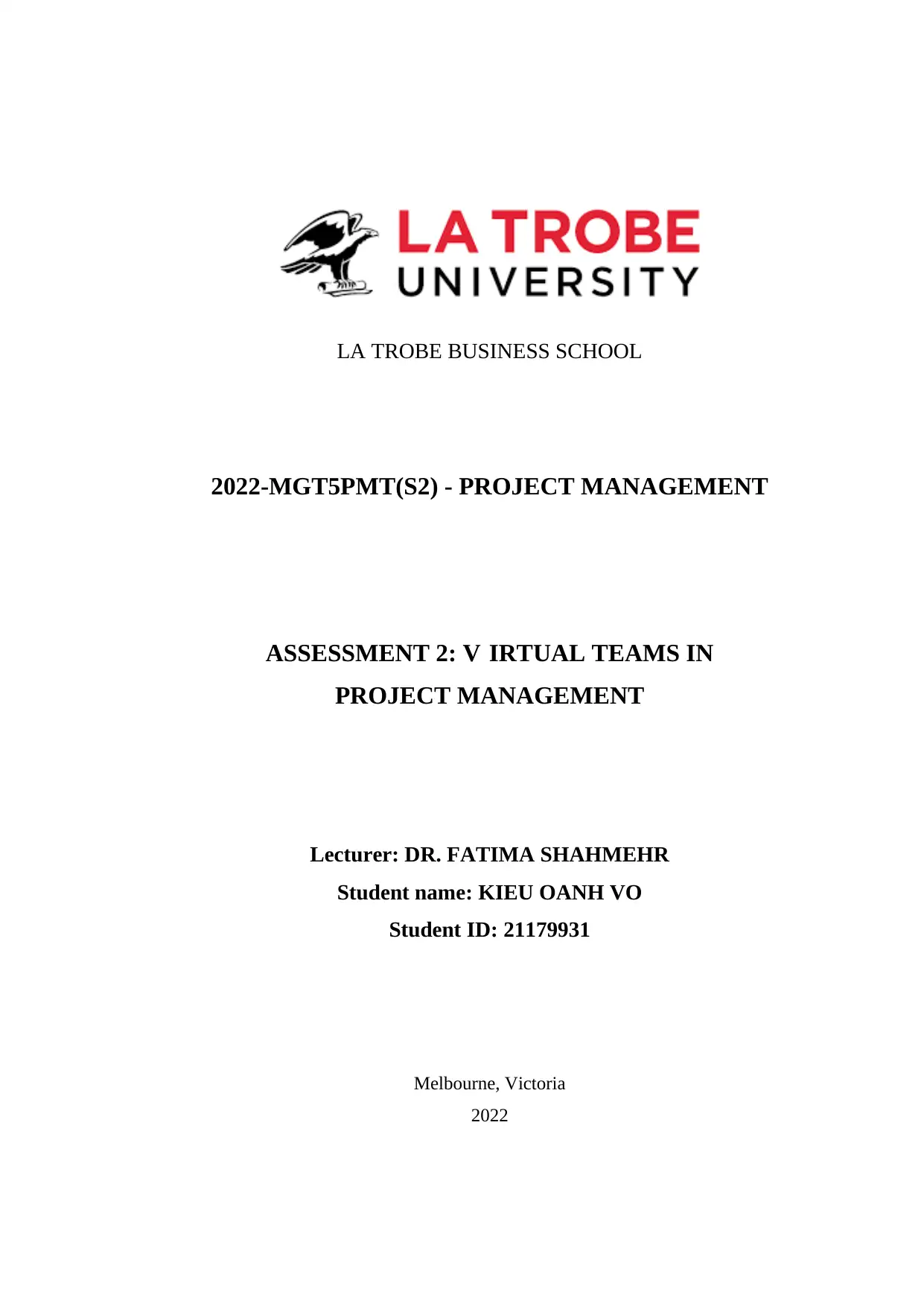
LA TROBE BUSINESS SCHOOL
2022-MGT5PMT(S2) - PROJECT MANAGEMENT
ASSESSMENT 2: V IRTUAL TEAMS IN
PROJECT MANAGEMENT
Lecturer: DR. FATIMA SHAHMEHR
Student name: KIEU OANH VO
Student ID: 21179931
Melbourne, Victoria
2022
2022-MGT5PMT(S2) - PROJECT MANAGEMENT
ASSESSMENT 2: V IRTUAL TEAMS IN
PROJECT MANAGEMENT
Lecturer: DR. FATIMA SHAHMEHR
Student name: KIEU OANH VO
Student ID: 21179931
Melbourne, Victoria
2022
Paraphrase This Document
Need a fresh take? Get an instant paraphrase of this document with our AI Paraphraser
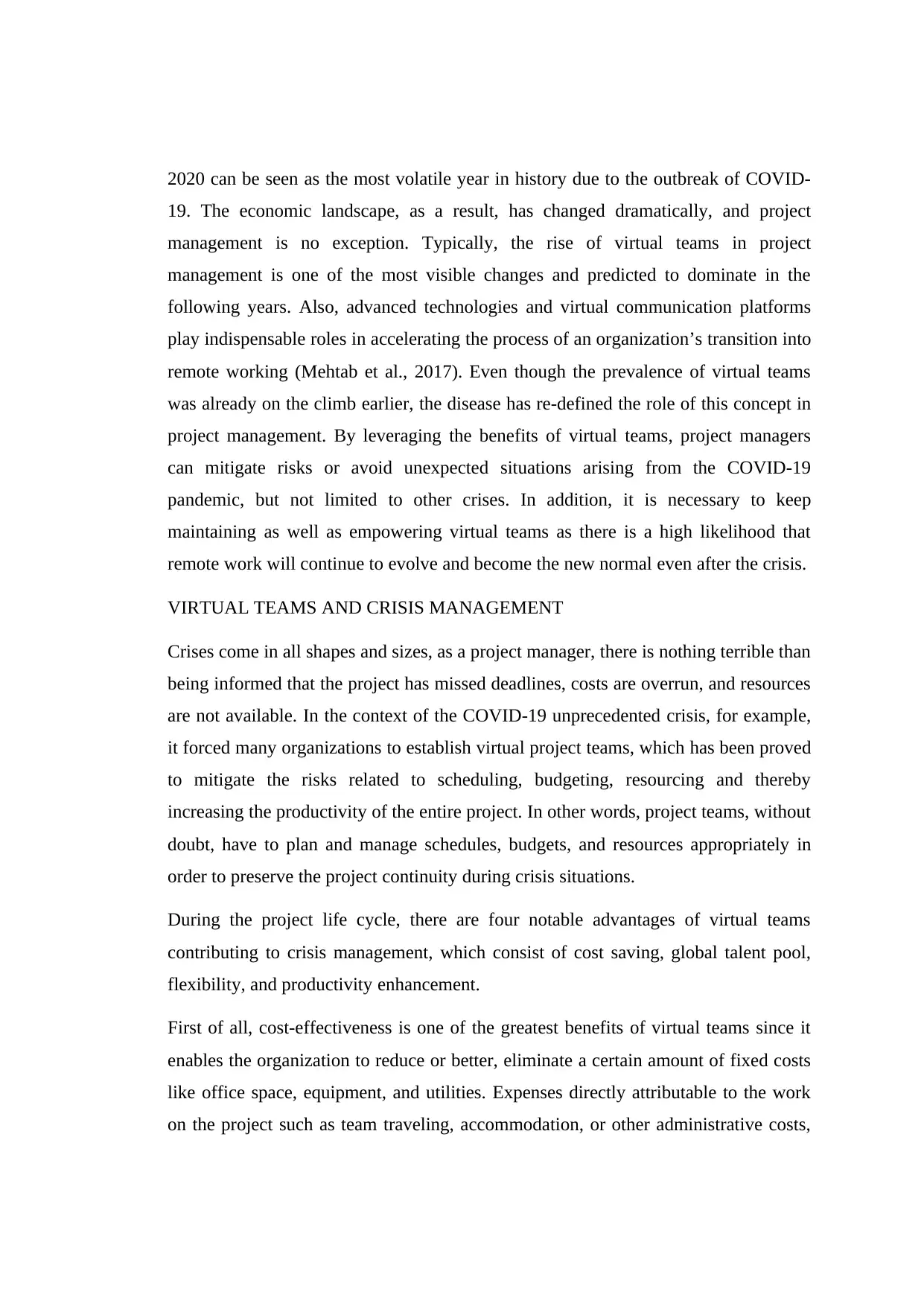
2020 can be seen as the most volatile year in history due to the outbreak of COVID-
19. The economic landscape, as a result, has changed dramatically, and project
management is no exception. Typically, the rise of virtual teams in project
management is one of the most visible changes and predicted to dominate in the
following years. Also, advanced technologies and virtual communication platforms
play indispensable roles in accelerating the process of an organization’s transition into
remote working (Mehtab et al., 2017). Even though the prevalence of virtual teams
was already on the climb earlier, the disease has re-defined the role of this concept in
project management. By leveraging the benefits of virtual teams, project managers
can mitigate risks or avoid unexpected situations arising from the COVID-19
pandemic, but not limited to other crises. In addition, it is necessary to keep
maintaining as well as empowering virtual teams as there is a high likelihood that
remote work will continue to evolve and become the new normal even after the crisis.
VIRTUAL TEAMS AND CRISIS MANAGEMENT
Crises come in all shapes and sizes, as a project manager, there is nothing terrible than
being informed that the project has missed deadlines, costs are overrun, and resources
are not available. In the context of the COVID-19 unprecedented crisis, for example,
it forced many organizations to establish virtual project teams, which has been proved
to mitigate the risks related to scheduling, budgeting, resourcing and thereby
increasing the productivity of the entire project. In other words, project teams, without
doubt, have to plan and manage schedules, budgets, and resources appropriately in
order to preserve the project continuity during crisis situations.
During the project life cycle, there are four notable advantages of virtual teams
contributing to crisis management, which consist of cost saving, global talent pool,
flexibility, and productivity enhancement.
First of all, cost-effectiveness is one of the greatest benefits of virtual teams since it
enables the organization to reduce or better, eliminate a certain amount of fixed costs
like office space, equipment, and utilities. Expenses directly attributable to the work
on the project such as team traveling, accommodation, or other administrative costs,
19. The economic landscape, as a result, has changed dramatically, and project
management is no exception. Typically, the rise of virtual teams in project
management is one of the most visible changes and predicted to dominate in the
following years. Also, advanced technologies and virtual communication platforms
play indispensable roles in accelerating the process of an organization’s transition into
remote working (Mehtab et al., 2017). Even though the prevalence of virtual teams
was already on the climb earlier, the disease has re-defined the role of this concept in
project management. By leveraging the benefits of virtual teams, project managers
can mitigate risks or avoid unexpected situations arising from the COVID-19
pandemic, but not limited to other crises. In addition, it is necessary to keep
maintaining as well as empowering virtual teams as there is a high likelihood that
remote work will continue to evolve and become the new normal even after the crisis.
VIRTUAL TEAMS AND CRISIS MANAGEMENT
Crises come in all shapes and sizes, as a project manager, there is nothing terrible than
being informed that the project has missed deadlines, costs are overrun, and resources
are not available. In the context of the COVID-19 unprecedented crisis, for example,
it forced many organizations to establish virtual project teams, which has been proved
to mitigate the risks related to scheduling, budgeting, resourcing and thereby
increasing the productivity of the entire project. In other words, project teams, without
doubt, have to plan and manage schedules, budgets, and resources appropriately in
order to preserve the project continuity during crisis situations.
During the project life cycle, there are four notable advantages of virtual teams
contributing to crisis management, which consist of cost saving, global talent pool,
flexibility, and productivity enhancement.
First of all, cost-effectiveness is one of the greatest benefits of virtual teams since it
enables the organization to reduce or better, eliminate a certain amount of fixed costs
like office space, equipment, and utilities. Expenses directly attributable to the work
on the project such as team traveling, accommodation, or other administrative costs,
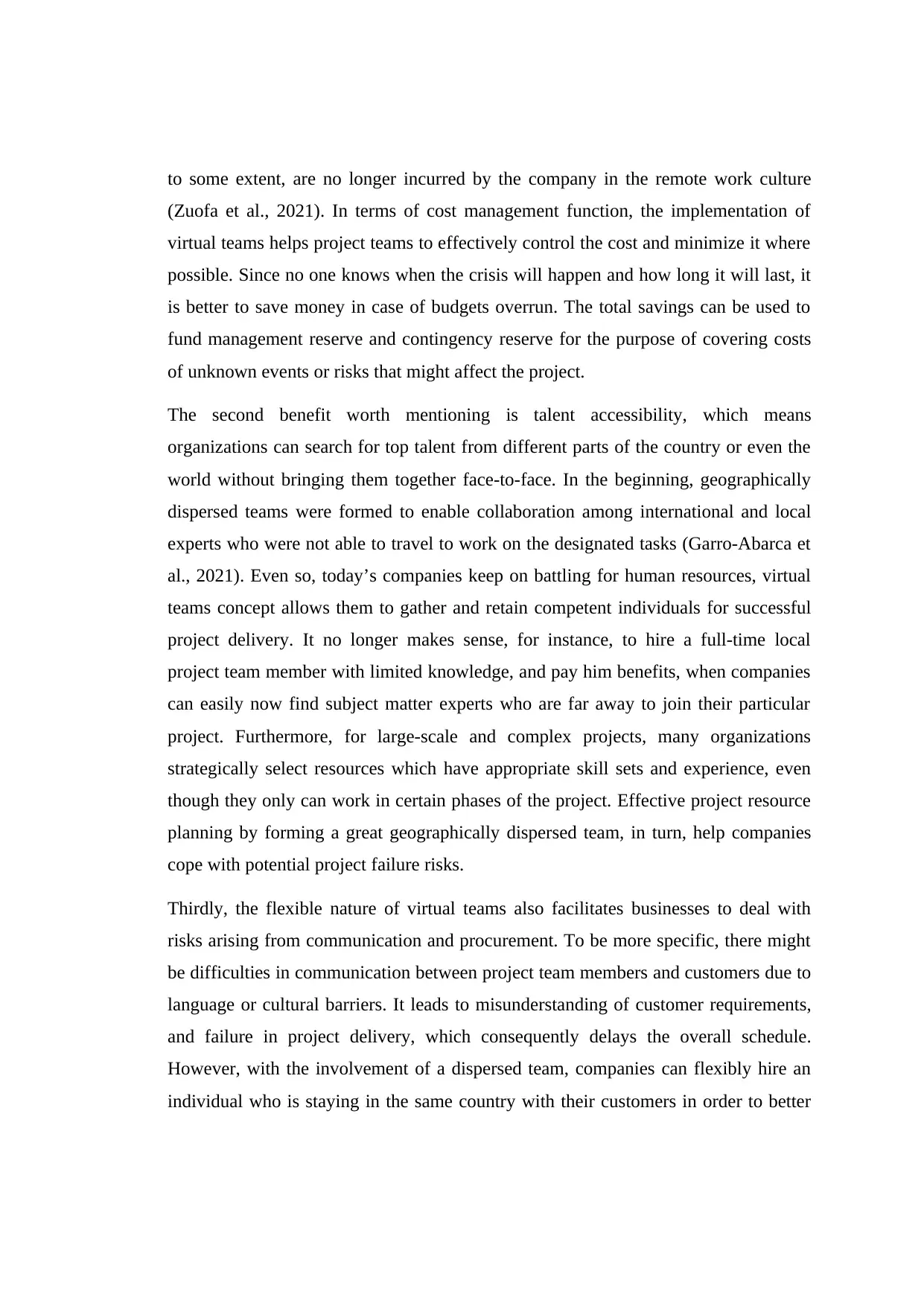
to some extent, are no longer incurred by the company in the remote work culture
(Zuofa et al., 2021). In terms of cost management function, the implementation of
virtual teams helps project teams to effectively control the cost and minimize it where
possible. Since no one knows when the crisis will happen and how long it will last, it
is better to save money in case of budgets overrun. The total savings can be used to
fund management reserve and contingency reserve for the purpose of covering costs
of unknown events or risks that might affect the project.
The second benefit worth mentioning is talent accessibility, which means
organizations can search for top talent from different parts of the country or even the
world without bringing them together face-to-face. In the beginning, geographically
dispersed teams were formed to enable collaboration among international and local
experts who were not able to travel to work on the designated tasks (Garro-Abarca et
al., 2021). Even so, today’s companies keep on battling for human resources, virtual
teams concept allows them to gather and retain competent individuals for successful
project delivery. It no longer makes sense, for instance, to hire a full-time local
project team member with limited knowledge, and pay him benefits, when companies
can easily now find subject matter experts who are far away to join their particular
project. Furthermore, for large-scale and complex projects, many organizations
strategically select resources which have appropriate skill sets and experience, even
though they only can work in certain phases of the project. Effective project resource
planning by forming a great geographically dispersed team, in turn, help companies
cope with potential project failure risks.
Thirdly, the flexible nature of virtual teams also facilitates businesses to deal with
risks arising from communication and procurement. To be more specific, there might
be difficulties in communication between project team members and customers due to
language or cultural barriers. It leads to misunderstanding of customer requirements,
and failure in project delivery, which consequently delays the overall schedule.
However, with the involvement of a dispersed team, companies can flexibly hire an
individual who is staying in the same country with their customers in order to better
(Zuofa et al., 2021). In terms of cost management function, the implementation of
virtual teams helps project teams to effectively control the cost and minimize it where
possible. Since no one knows when the crisis will happen and how long it will last, it
is better to save money in case of budgets overrun. The total savings can be used to
fund management reserve and contingency reserve for the purpose of covering costs
of unknown events or risks that might affect the project.
The second benefit worth mentioning is talent accessibility, which means
organizations can search for top talent from different parts of the country or even the
world without bringing them together face-to-face. In the beginning, geographically
dispersed teams were formed to enable collaboration among international and local
experts who were not able to travel to work on the designated tasks (Garro-Abarca et
al., 2021). Even so, today’s companies keep on battling for human resources, virtual
teams concept allows them to gather and retain competent individuals for successful
project delivery. It no longer makes sense, for instance, to hire a full-time local
project team member with limited knowledge, and pay him benefits, when companies
can easily now find subject matter experts who are far away to join their particular
project. Furthermore, for large-scale and complex projects, many organizations
strategically select resources which have appropriate skill sets and experience, even
though they only can work in certain phases of the project. Effective project resource
planning by forming a great geographically dispersed team, in turn, help companies
cope with potential project failure risks.
Thirdly, the flexible nature of virtual teams also facilitates businesses to deal with
risks arising from communication and procurement. To be more specific, there might
be difficulties in communication between project team members and customers due to
language or cultural barriers. It leads to misunderstanding of customer requirements,
and failure in project delivery, which consequently delays the overall schedule.
However, with the involvement of a dispersed team, companies can flexibly hire an
individual who is staying in the same country with their customers in order to better
⊘ This is a preview!⊘
Do you want full access?
Subscribe today to unlock all pages.

Trusted by 1+ million students worldwide
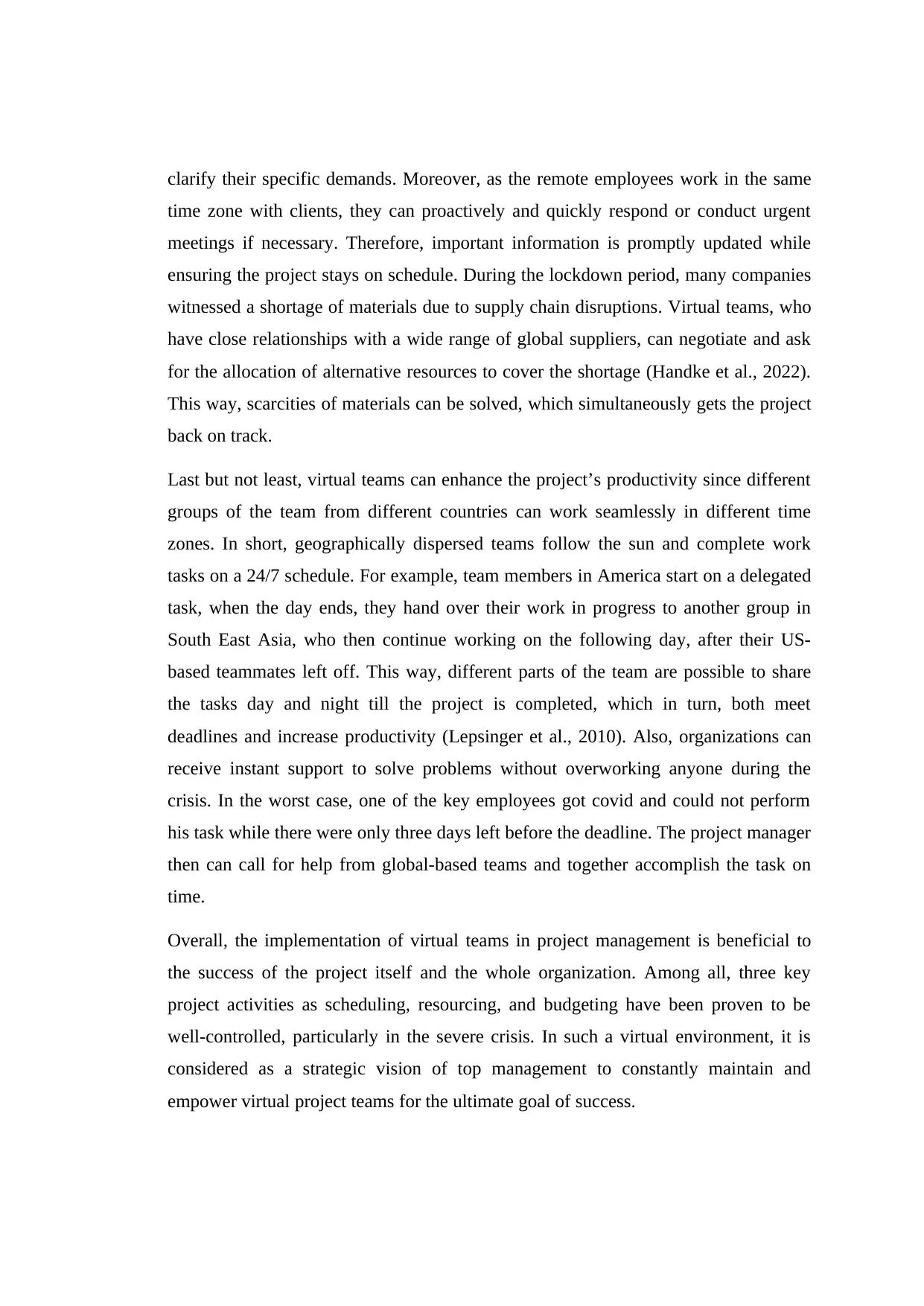
clarify their specific demands. Moreover, as the remote employees work in the same
time zone with clients, they can proactively and quickly respond or conduct urgent
meetings if necessary. Therefore, important information is promptly updated while
ensuring the project stays on schedule. During the lockdown period, many companies
witnessed a shortage of materials due to supply chain disruptions. Virtual teams, who
have close relationships with a wide range of global suppliers, can negotiate and ask
for the allocation of alternative resources to cover the shortage (Handke et al., 2022).
This way, scarcities of materials can be solved, which simultaneously gets the project
back on track.
Last but not least, virtual teams can enhance the project’s productivity since different
groups of the team from different countries can work seamlessly in different time
zones. In short, geographically dispersed teams follow the sun and complete work
tasks on a 24/7 schedule. For example, team members in America start on a delegated
task, when the day ends, they hand over their work in progress to another group in
South East Asia, who then continue working on the following day, after their US-
based teammates left off. This way, different parts of the team are possible to share
the tasks day and night till the project is completed, which in turn, both meet
deadlines and increase productivity (Lepsinger et al., 2010). Also, organizations can
receive instant support to solve problems without overworking anyone during the
crisis. In the worst case, one of the key employees got covid and could not perform
his task while there were only three days left before the deadline. The project manager
then can call for help from global-based teams and together accomplish the task on
time.
Overall, the implementation of virtual teams in project management is beneficial to
the success of the project itself and the whole organization. Among all, three key
project activities as scheduling, resourcing, and budgeting have been proven to be
well-controlled, particularly in the severe crisis. In such a virtual environment, it is
considered as a strategic vision of top management to constantly maintain and
empower virtual project teams for the ultimate goal of success.
time zone with clients, they can proactively and quickly respond or conduct urgent
meetings if necessary. Therefore, important information is promptly updated while
ensuring the project stays on schedule. During the lockdown period, many companies
witnessed a shortage of materials due to supply chain disruptions. Virtual teams, who
have close relationships with a wide range of global suppliers, can negotiate and ask
for the allocation of alternative resources to cover the shortage (Handke et al., 2022).
This way, scarcities of materials can be solved, which simultaneously gets the project
back on track.
Last but not least, virtual teams can enhance the project’s productivity since different
groups of the team from different countries can work seamlessly in different time
zones. In short, geographically dispersed teams follow the sun and complete work
tasks on a 24/7 schedule. For example, team members in America start on a delegated
task, when the day ends, they hand over their work in progress to another group in
South East Asia, who then continue working on the following day, after their US-
based teammates left off. This way, different parts of the team are possible to share
the tasks day and night till the project is completed, which in turn, both meet
deadlines and increase productivity (Lepsinger et al., 2010). Also, organizations can
receive instant support to solve problems without overworking anyone during the
crisis. In the worst case, one of the key employees got covid and could not perform
his task while there were only three days left before the deadline. The project manager
then can call for help from global-based teams and together accomplish the task on
time.
Overall, the implementation of virtual teams in project management is beneficial to
the success of the project itself and the whole organization. Among all, three key
project activities as scheduling, resourcing, and budgeting have been proven to be
well-controlled, particularly in the severe crisis. In such a virtual environment, it is
considered as a strategic vision of top management to constantly maintain and
empower virtual project teams for the ultimate goal of success.
Paraphrase This Document
Need a fresh take? Get an instant paraphrase of this document with our AI Paraphraser
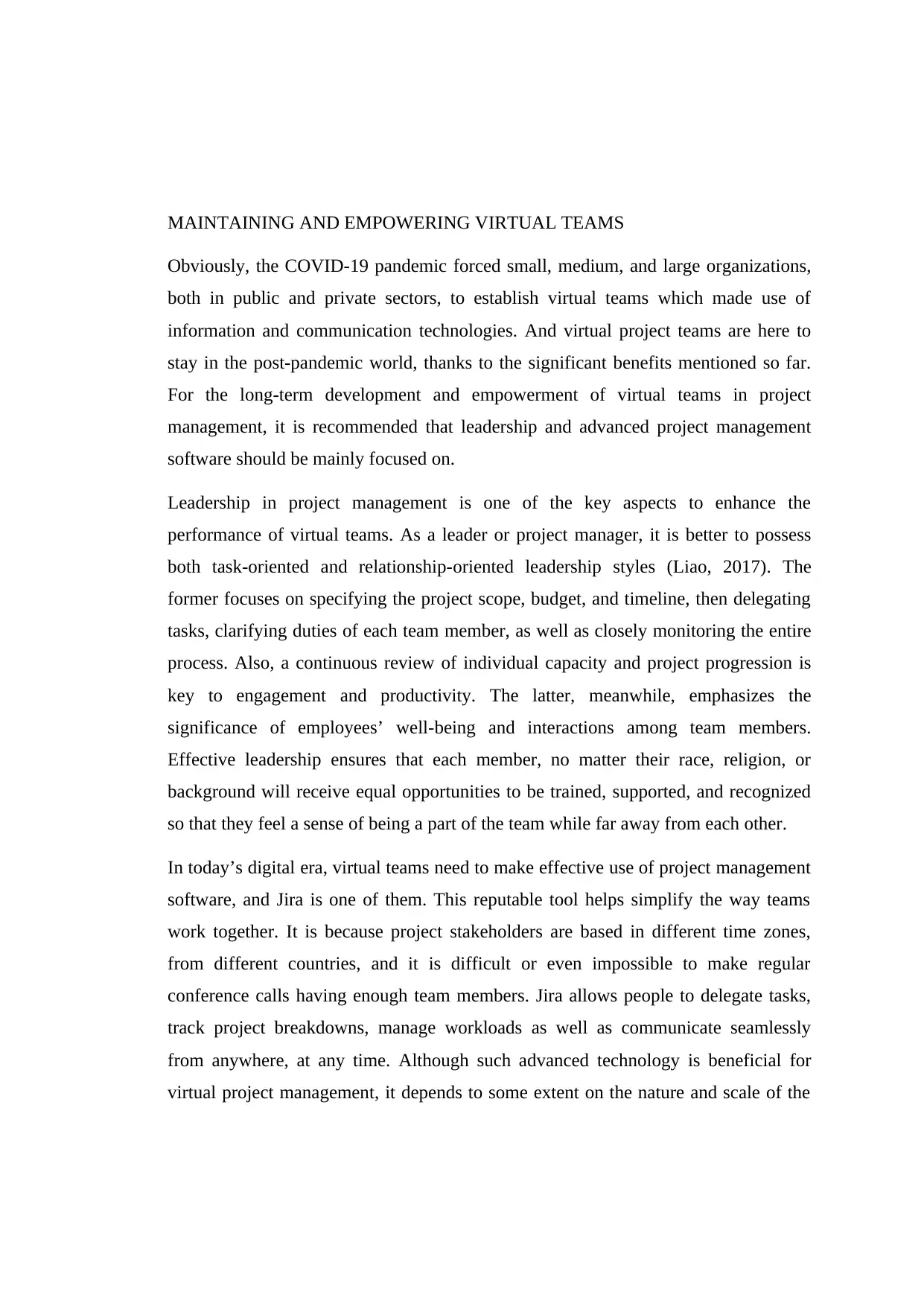
MAINTAINING AND EMPOWERING VIRTUAL TEAMS
Obviously, the COVID-19 pandemic forced small, medium, and large organizations,
both in public and private sectors, to establish virtual teams which made use of
information and communication technologies. And virtual project teams are here to
stay in the post-pandemic world, thanks to the significant benefits mentioned so far.
For the long-term development and empowerment of virtual teams in project
management, it is recommended that leadership and advanced project management
software should be mainly focused on.
Leadership in project management is one of the key aspects to enhance the
performance of virtual teams. As a leader or project manager, it is better to possess
both task-oriented and relationship-oriented leadership styles (Liao, 2017). The
former focuses on specifying the project scope, budget, and timeline, then delegating
tasks, clarifying duties of each team member, as well as closely monitoring the entire
process. Also, a continuous review of individual capacity and project progression is
key to engagement and productivity. The latter, meanwhile, emphasizes the
significance of employees’ well-being and interactions among team members.
Effective leadership ensures that each member, no matter their race, religion, or
background will receive equal opportunities to be trained, supported, and recognized
so that they feel a sense of being a part of the team while far away from each other.
In today’s digital era, virtual teams need to make effective use of project management
software, and Jira is one of them. This reputable tool helps simplify the way teams
work together. It is because project stakeholders are based in different time zones,
from different countries, and it is difficult or even impossible to make regular
conference calls having enough team members. Jira allows people to delegate tasks,
track project breakdowns, manage workloads as well as communicate seamlessly
from anywhere, at any time. Although such advanced technology is beneficial for
virtual project management, it depends to some extent on the nature and scale of the
Obviously, the COVID-19 pandemic forced small, medium, and large organizations,
both in public and private sectors, to establish virtual teams which made use of
information and communication technologies. And virtual project teams are here to
stay in the post-pandemic world, thanks to the significant benefits mentioned so far.
For the long-term development and empowerment of virtual teams in project
management, it is recommended that leadership and advanced project management
software should be mainly focused on.
Leadership in project management is one of the key aspects to enhance the
performance of virtual teams. As a leader or project manager, it is better to possess
both task-oriented and relationship-oriented leadership styles (Liao, 2017). The
former focuses on specifying the project scope, budget, and timeline, then delegating
tasks, clarifying duties of each team member, as well as closely monitoring the entire
process. Also, a continuous review of individual capacity and project progression is
key to engagement and productivity. The latter, meanwhile, emphasizes the
significance of employees’ well-being and interactions among team members.
Effective leadership ensures that each member, no matter their race, religion, or
background will receive equal opportunities to be trained, supported, and recognized
so that they feel a sense of being a part of the team while far away from each other.
In today’s digital era, virtual teams need to make effective use of project management
software, and Jira is one of them. This reputable tool helps simplify the way teams
work together. It is because project stakeholders are based in different time zones,
from different countries, and it is difficult or even impossible to make regular
conference calls having enough team members. Jira allows people to delegate tasks,
track project breakdowns, manage workloads as well as communicate seamlessly
from anywhere, at any time. Although such advanced technology is beneficial for
virtual project management, it depends to some extent on the nature and scale of the
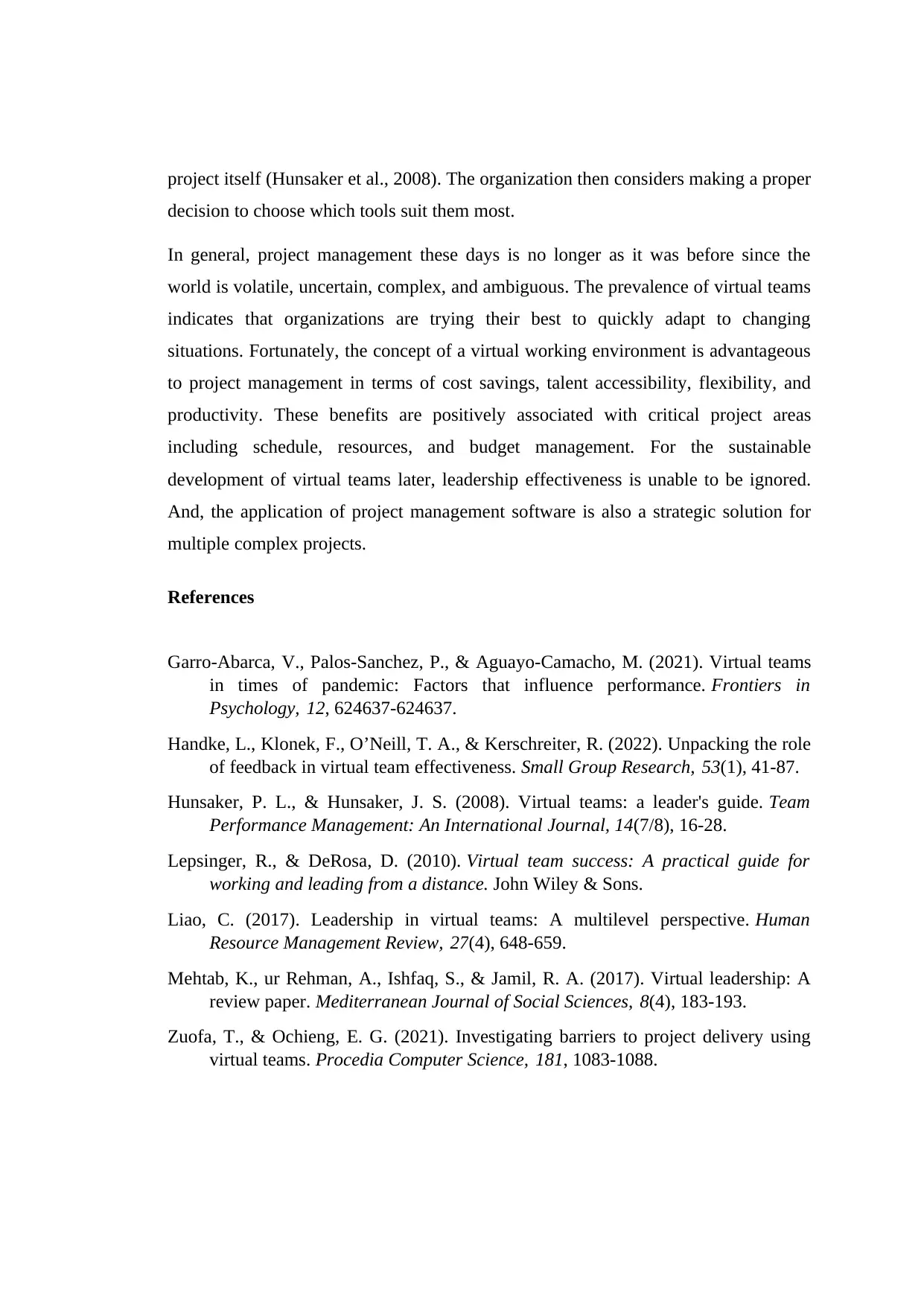
project itself (Hunsaker et al., 2008). The organization then considers making a proper
decision to choose which tools suit them most.
In general, project management these days is no longer as it was before since the
world is volatile, uncertain, complex, and ambiguous. The prevalence of virtual teams
indicates that organizations are trying their best to quickly adapt to changing
situations. Fortunately, the concept of a virtual working environment is advantageous
to project management in terms of cost savings, talent accessibility, flexibility, and
productivity. These benefits are positively associated with critical project areas
including schedule, resources, and budget management. For the sustainable
development of virtual teams later, leadership effectiveness is unable to be ignored.
And, the application of project management software is also a strategic solution for
multiple complex projects.
References
Garro-Abarca, V., Palos-Sanchez, P., & Aguayo-Camacho, M. (2021). Virtual teams
in times of pandemic: Factors that influence performance. Frontiers in
Psychology, 12, 624637-624637.
Handke, L., Klonek, F., O’Neill, T. A., & Kerschreiter, R. (2022). Unpacking the role
of feedback in virtual team effectiveness. Small Group Research, 53(1), 41-87.
Hunsaker, P. L., & Hunsaker, J. S. (2008). Virtual teams: a leader's guide. Team
Performance Management: An International Journal, 14(7/8), 16-28.
Lepsinger, R., & DeRosa, D. (2010). Virtual team success: A practical guide for
working and leading from a distance. John Wiley & Sons.
Liao, C. (2017). Leadership in virtual teams: A multilevel perspective. Human
Resource Management Review, 27(4), 648-659.
Mehtab, K., ur Rehman, A., Ishfaq, S., & Jamil, R. A. (2017). Virtual leadership: A
review paper. Mediterranean Journal of Social Sciences, 8(4), 183-193.
Zuofa, T., & Ochieng, E. G. (2021). Investigating barriers to project delivery using
virtual teams. Procedia Computer Science, 181, 1083-1088.
decision to choose which tools suit them most.
In general, project management these days is no longer as it was before since the
world is volatile, uncertain, complex, and ambiguous. The prevalence of virtual teams
indicates that organizations are trying their best to quickly adapt to changing
situations. Fortunately, the concept of a virtual working environment is advantageous
to project management in terms of cost savings, talent accessibility, flexibility, and
productivity. These benefits are positively associated with critical project areas
including schedule, resources, and budget management. For the sustainable
development of virtual teams later, leadership effectiveness is unable to be ignored.
And, the application of project management software is also a strategic solution for
multiple complex projects.
References
Garro-Abarca, V., Palos-Sanchez, P., & Aguayo-Camacho, M. (2021). Virtual teams
in times of pandemic: Factors that influence performance. Frontiers in
Psychology, 12, 624637-624637.
Handke, L., Klonek, F., O’Neill, T. A., & Kerschreiter, R. (2022). Unpacking the role
of feedback in virtual team effectiveness. Small Group Research, 53(1), 41-87.
Hunsaker, P. L., & Hunsaker, J. S. (2008). Virtual teams: a leader's guide. Team
Performance Management: An International Journal, 14(7/8), 16-28.
Lepsinger, R., & DeRosa, D. (2010). Virtual team success: A practical guide for
working and leading from a distance. John Wiley & Sons.
Liao, C. (2017). Leadership in virtual teams: A multilevel perspective. Human
Resource Management Review, 27(4), 648-659.
Mehtab, K., ur Rehman, A., Ishfaq, S., & Jamil, R. A. (2017). Virtual leadership: A
review paper. Mediterranean Journal of Social Sciences, 8(4), 183-193.
Zuofa, T., & Ochieng, E. G. (2021). Investigating barriers to project delivery using
virtual teams. Procedia Computer Science, 181, 1083-1088.
⊘ This is a preview!⊘
Do you want full access?
Subscribe today to unlock all pages.

Trusted by 1+ million students worldwide

1 out of 7
Related Documents
Your All-in-One AI-Powered Toolkit for Academic Success.
+13062052269
info@desklib.com
Available 24*7 on WhatsApp / Email
![[object Object]](/_next/static/media/star-bottom.7253800d.svg)
Unlock your academic potential
Copyright © 2020–2025 A2Z Services. All Rights Reserved. Developed and managed by ZUCOL.


![Project Scheduling and Time Management Report - [Course Name]](/_next/image/?url=https%3A%2F%2Fdesklib.com%2Fmedia%2Fimages%2Fvl%2F08ca5540273c481b91219691dd50a94c.jpg&w=256&q=75)


